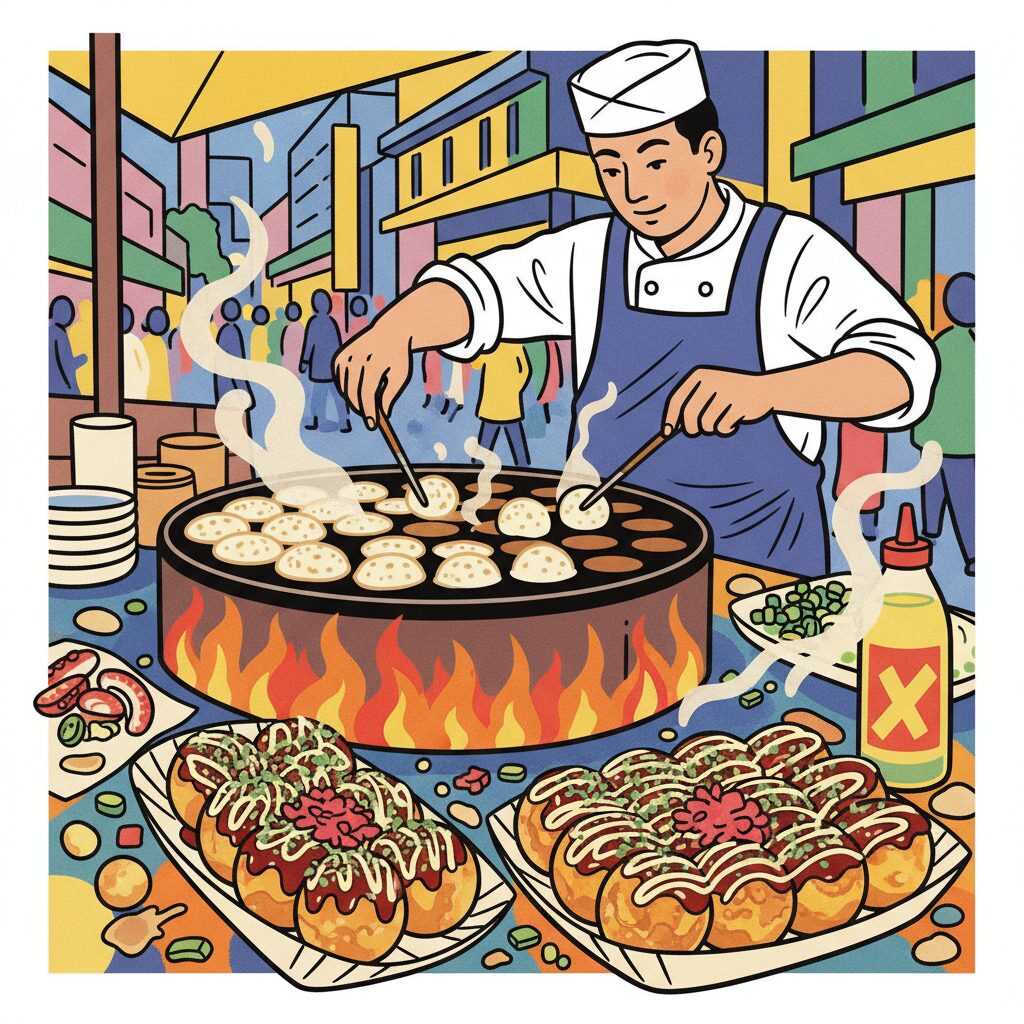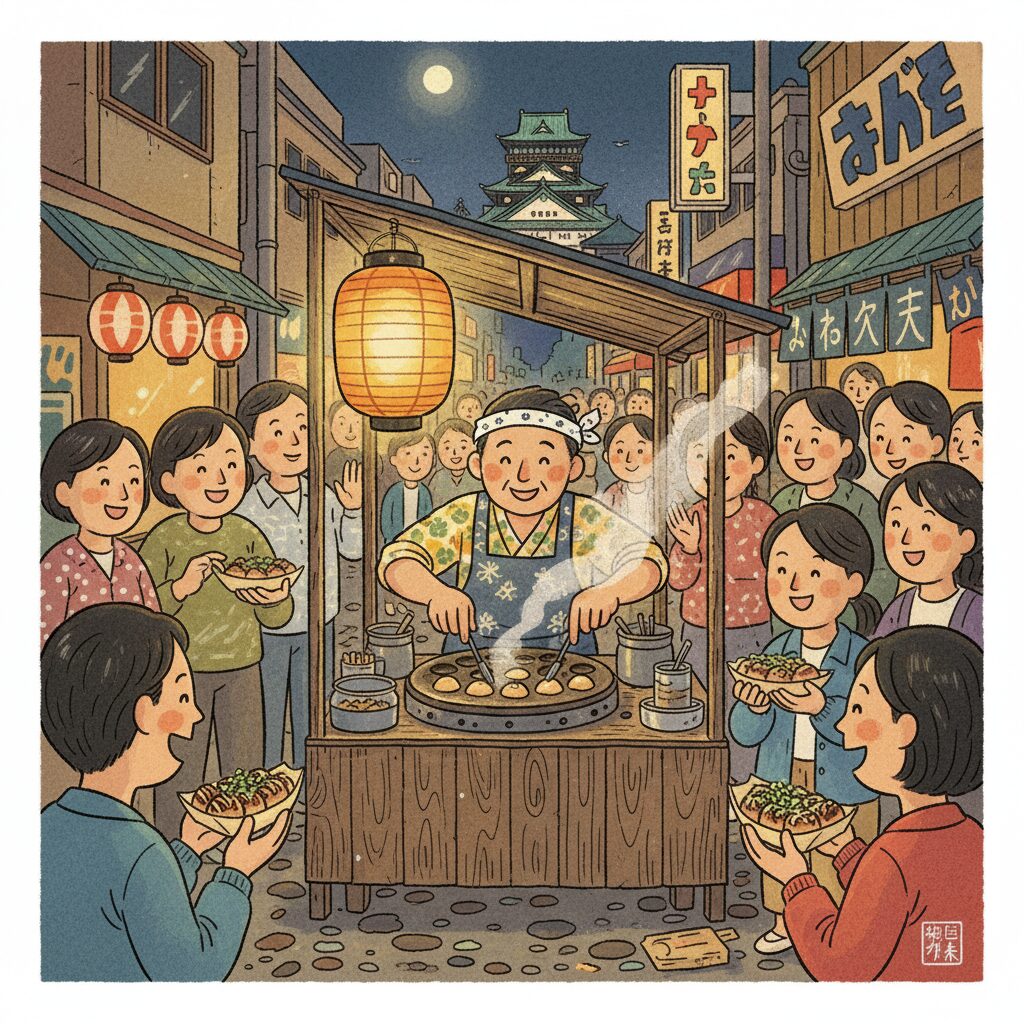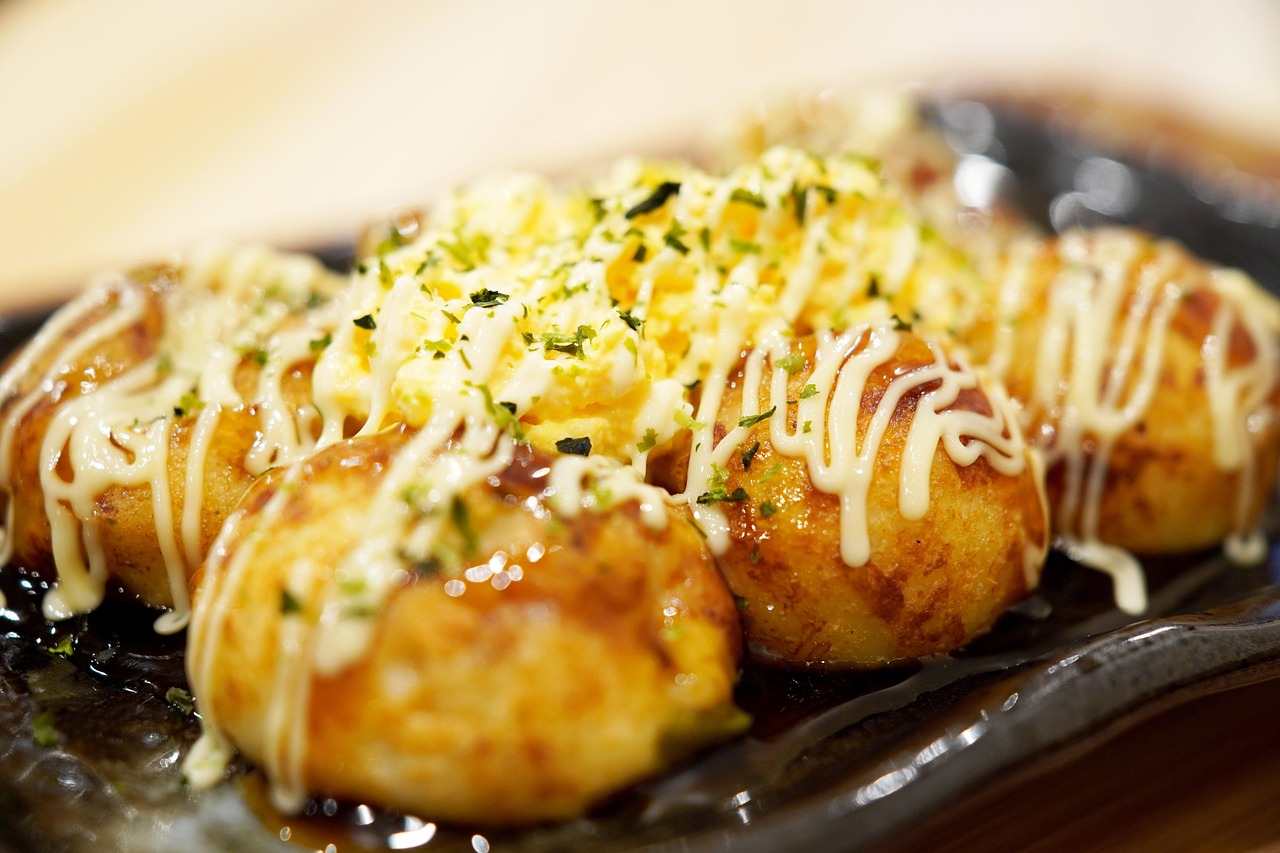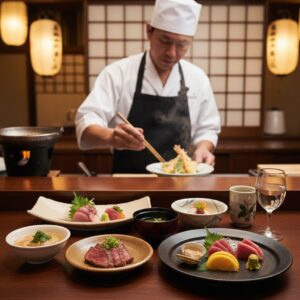Step off the rumbling train at Tenma Station, and you don’t just arrive at a place; you plunge into an atmosphere. The air itself feels different here, thick with the savory steam of grilling meats, the sweet scent of dashi broth, and the unmistakable, soul-soothing aroma of takoyaki sizzling on cast iron. This isn’t the polished, futuristic Japan of glossy travel brochures. This is Osaka, raw and unfiltered, the nation’s celebrated kitchen, and you’ve just walked into its vibrant, beating heart. In a city defined by its devotion to food—a culture encapsulated in the word ‘kuidaore,’ to eat oneself into ruin—one dish stands as the undisputed champion of the people: takoyaki. These humble, piping-hot balls of octopus-filled batter are more than just a snack; they are a culinary icon, a symbol of Osakan identity, and a delicious excuse for community. To understand Osaka, you must understand its takoyaki. And to truly understand takoyaki, you must leave the tourist trails behind and dive headfirst into the labyrinthine, lantern-lit alleyways of Tenma. This is not just a food guide; it’s an invitation to a pilgrimage, a takoyaki-hopping journey through the neighborhood that locals cherish, where every stall tells a story and every bite is a taste of home. Forget what you think you know about street food. Tonight, we dance the takoyaki tango.
While the takoyaki tango is the star of Tenma’s show, the neighborhood is also a fantastic starting point for exploring other iconic Osaka foods, including the city’s famous kushikatsu.
The Soul of Osaka on a Griddle: What is Takoyaki?

Before we begin our journey, let’s become acquainted with our protagonist. To describe takoyaki as mere ‘octopus balls’ is like calling a symphony just a collection of notes. It overlooks the artistry, the history, and the deep, complex flavors packed into each delicate sphere. At its essence, takoyaki is a deceptively simple creation born from the resourcefulness and culinary creativity of post-war Osaka. A street vendor named Tomekichi Endo is often credited with inventing it in 1935, adapting a similar dish called akashiyaki from the nearby city of Akashi. Whereas akashiyaki was an airy, egg-rich dumpling dipped in broth, takoyaki was conceived as a more robust, self-contained burst of flavor, perfectly suited to the fast-paced, food-loving streets of Osaka.
The magic starts with the batter, which is no ordinary pancake mix. It’s a carefully balanced blend of wheat flour and, most importantly, dashi. Dashi is the cornerstone broth of Japanese cuisine, a clear stock rich in umami, typically made from kombu (kelp) and katsuobushi (dried, smoked bonito flakes). The quality of the dashi shapes the soul of the takoyaki. A great dashi imparts a deep, savory, almost oceanic flavor to the batter, creating the perfect base for the other ingredients. Within this liquid gold, a medley of textures and flavors comes together. First, there are the tenkasu—crispy bits of deep-fried tempura batter—that add delightful crunch and soak up surrounding flavors. Next is beni shoga, bright red pickled ginger, which cuts through the richness with a sharp, palate-cleansing bite. Finely chopped green onions, or negi, add a fresh, mildly pungent contrast. And at the heart of it all is the centerpiece: a generous chunk of tako, or octopus. The octopus must be tender yet maintain a satisfying chew, its subtle sweetness perfectly anchoring the savory batter.
Watching a takoyaki master at work is like witnessing a dance of rhythm and finesse. They stand before a heavy cast-iron griddle dotted with dozens of hemispherical molds. With fluid precision, they pour the dashi-rich batter, filling each mold to the brim. The ingredients are quickly scattered over the surface before the true craftsmanship begins. Equipped with two sharp metal picks called kushi, the vendor moves with practiced speed and grace. They skillfully separate the batter, tucking overflowing edges into each sphere and, with a flick of the wrist, start turning them. This step is critical. The constant, rhythmic turning cooks the takoyaki evenly, forming a delicate, crispy shell while keeping the inside luxuriously molten and creamy. This signature textural contrast, known as ‘soto-kari, naka-toro’ (crispy outside, melty inside), defines authentic Osaka takoyaki.
Once the spheres are golden brown and perfectly rounded, they are scooped into a boat-shaped tray, traditionally made from wood or bamboo. But the creation isn’t finished yet. The final touch is a cascade of toppings that completes the flavor experience. A generous zigzag of thick, sweet-and-savory takoyaki sauce, reminiscent of Japanese barbecue sauce, is added first. This is followed by a rich lattice of Japanese mayonnaise, which is creamier and tangier than its Western counterpart. Next, a blizzard of katsuobushi is sprinkled on top. The paper-thin bonito flakes, reacting to the heat, curl and quiver as if alive, a spectacle often called ‘dancing bonito flakes.’ Lastly, a dusting of aonori, or green laver, adds a final layer of oceanic umami. The result is a street food masterpiece—a harmonious blend of sweet, savory, tangy, and creamy flavors, with textures that range from crispy and crunchy to chewy and gooey. It’s a dish that delights all the senses, a complete meal in a few perfect bites, and a lasting culinary symbol of Osaka’s lively spirit.
Welcome to Tenma: The Labyrinth of Local Flavors
Now that you appreciate the art, it’s time to locate the gallery. Tenma is our target, a district buzzing with its own unique energy. Tucked just beneath the tracks of the JR Osaka Loop Line, only one stop from the vast commercial center of Umeda, Tenma feels like a different world. There are no towering skyscrapers or luxury boutiques here. Instead, you’ll discover a sprawling, delightfully chaotic maze of narrow streets, covered shopping arcades, and hidden alleyways, each packed with tiny restaurants, standing bars (tachinomi), and food stalls. This is where Osaka’s salarymen come to relax, where families shop for groceries, and where the city’s passion for honest, unpretentious food shines brightest.
The neighborhood’s main lifeline is the Tenjimbashisuji Shotengai, a covered shopping arcade that proudly claims the title of the longest in Japan. Stretching an impressive 2.6 kilometers, it’s a city within a city—a vibrant corridor of commerce and community where you can find everything from fresh produce and traditional sweets to kimonos and affordable electronics. While the main arcade is a spectacle in itself, the true magic of Tenma lies in the smaller streets branching off from it. Step into any of these side alleys, and you’ll be surrounded by a maze of red paper lanterns (chochin) casting a warm, welcoming glow on the pavement. The air is filled with a symphony of tempting aromas: the charcoal smoke from a yakitori grill, the sharp tang of vinegar from a sushi counter, and everywhere, the comforting, wheaty scent of takoyaki batter hitting a hot griddle.
The atmosphere becomes electric as evening falls. The gentle afternoon buzz transforms into a joyous roar. The clinking of beer mugs, the sizzle of cooking food, the raucous laughter of friends and coworkers squeezed into impossibly small izakayas—it all blends into the soundtrack of authentic Osakan life. This is not a place for silent reflection; it’s a place to join in, to dive headfirst into the joyful chaos. The people are welcoming, the prices fair, and the food taken seriously. In Tenma, you don’t just eat; you celebrate. And at the center of that celebration, you’ll always find takoyaki. Here, it’s more than just one option among many; it’s the fundamental snack, the essential fuel for a night spent exploring the seemingly endless culinary delights the neighborhood offers. Our journey begins at the station, the gateway to this culinary paradise.
The First Stop: The Classic Gateway Takoyaki

Our pilgrimage starts just a few steps from the train station’s exit, where the aroma of sizzling batter serves as an irresistible siren’s call. Here, tucked among pachinko parlors and convenience stores, you’ll find a quintessential Tenma takoyaki stand. Let’s call it ‘Tako-han,’ a classic, no-frills spot that has been catering to hungry commuters and locals for decades. There’s no fancy seating—just a small window and a standing counter, worn smooth by the elbows of countless satisfied customers. The main attraction is the griddle’s theater, where a seasoned master, his movements a blur of efficiency, runs the show.
This is the ideal introduction to the platonic form of Osaka takoyaki. The style here is unapologetically traditional: ‘soto-kari, naka-toro.’ The exterior is fried to a perfect golden-brown crispness, yielding with a satisfying crunch to reveal an interior that is gloriously, almost dangerously, molten. The batter is rich with the deep, savory notes of finely crafted dashi, a flavor that speaks of care and tradition. Ordering is simple—you choose your quantity, typically six, eight, or ten pieces, and whether you want the full complement of sauce, mayonnaise, katsuobushi, and aonori. For your first taste, the answer should always be a resounding yes.
As the vendor hands you the steaming, boat-shaped tray, the first thing you’ll notice is the dance of the paper-thin bonito flakes, catching the rising heat as they twist and shimmer—a mesmerizing prelude to the flavor explosion ahead. A word of caution for the uninitiated: be patient. These spheres are tiny culinary volcanoes filled with superheated, creamy batter. The local technique is not to pop one whole into your mouth but to use your toothpick to poke a small hole in the top, letting the steam escape and the contents cool just enough to be manageable. Take your first bite. The initial crunch of the shell gives way to the velvety, dashi-infused interior. The chew of tender octopus provides the perfect textural anchor. Then the toppings come into play: the sweet and tangy sauce, the creamy richness of mayo, the smoky umami of the dancing bonito, and the subtle maritime note of aonori. It is a complex, multi-layered experience that is both comforting and thrilling. This is the baseline, the standard by which all other takoyaki on our journey will be measured. It is honest, delicious, and utterly Osakan.
Venturing Deeper: The Dashi-First Specialist
Energized by our initial taste of takoyaki perfection, we leave the bustling main street behind and venture into the quieter, more intimate backstreets of Tenma. The noise of the station gradually fades, replaced by the soft murmur of neighborhood life. It is here, tucked away down a narrow alley easily missed, that we locate our second stop. This takoyaki shop is a different kind altogether—a place we’ll name ‘Umami-do.’ This tiny stall is operated by an elderly couple who move with the slow, deliberate grace of artisans devoted to their craft. There is no flashy sign, only a simple noren curtain and the captivating aroma of their treasured dashi.
At Umami-do, the approach is distinct. The batter is not simply a container; it takes center stage. The couple’s secret lies in a dashi recipe handed down through generations—an exceptionally flavorful and complex broth that demands little else. The batter is lighter both in color and texture compared to our first stop. The goal isn’t a hard, crispy shell but a delicate, nearly silky skin gently enclosing the creamy interior. The octopus is top quality, yet it serves to enhance the batter rather than dominate it.
When you order here, the couple may gently recommend trying it ‘su,’ or plain, with just a light sprinkle of aonori, or perhaps a pinch of premium sea salt to highlight the dashi’s natural sweetness. Skipping the usual sauce and mayonnaise feels almost sacrilegious at first, but it is a gesture of trust in the artisan’s skill. The experience is eye-opening. Without the strong toppings, subtle nuances of the batter emerge— the deep, oceanic umami from the kombu, the faint smokiness of katsuobushi, and the natural sweetness of wheat flour. The flavor is cleaner and more refined. This is takoyaki in its purest form, a celebration of the Japanese culinary principle of enhancing the natural taste of top-quality ingredients. Eating it feels less like snacking and more like a tasting journey. It teaches appreciation for the dish’s foundation and offers a fresh perspective on what takoyaki can be. This quiet, profound counterpoint to the lively energy of our first stop proves that within a single dish lies a vast spectrum of culinary expression.
A Taste of Local Life: Pairing Takoyaki with Drinks
Takoyaki hopping is thirsty work, and in a neighborhood like Tenma, which boasts one of Osaka’s highest concentrations of drinking establishments, selecting the perfect drink is part of the adventure. The culture of eating here is deeply intertwined with drinking—it acts as a social lubricant, a palate cleanser, and a vital part of the ‘kuidaore’ experience. The classic and undisputed champion pairing for takoyaki is a cold, crisp Japanese lager. Brands like Asahi, Kirin, and Sapporo abound for good reason. The beer’s light body and sharp carbonation cut through the richness of takoyaki sauce and mayonnaise, cleansing the palate and prepping you for the next savory bite. It’s a simple, flawless match.
For an authentically local Tenma experience, you might choose a highball. A simple mix of Japanese whisky and highly carbonated soda water over ice in a tall glass, the highball is the Japanese izakaya’s go-to drink. It’s light, refreshing, and endlessly enjoyable, with the whisky’s subtle smokiness perfectly complementing the savory flavors of takoyaki. Many standing bars in Tenma specialize in highballs, offering various whiskies and house-made infusions that elevate this simple drink. Sipping a highball, standing shoulder-to-shoulder with locals while sharing steaming takoyaki beneath the warm glow of paper lanterns, is to truly experience the neighborhood’s soul.
Of course, alcohol isn’t necessary to enjoy the moment. A cold oolong tea is an excellent non-alcoholic choice, its mild bitterness and roasted notes serving a similar palate-cleansing role as beer. For a playful option, try Ramune, the classic Japanese soda known for its distinctive Codd-neck bottle sealed with a marble. The ritual of popping the marble into the bottle is a nostalgic delight for many Japanese, while its sweet, citrus flavor pairs refreshingly with savory takoyaki. Whatever your choice, taking a moment to enjoy a drink between takoyaki stops allows you to slow down, savor the vibrant atmosphere, and fully appreciate the rich tapestry of life that makes Tenma so special.
The Modern Twist: Experimental and Creative Takoyaki

Having rooted ourselves in tradition, it’s now time to explore the innovative side of Osaka’s beloved food. Our third stop leads us to a more contemporary venue, characterized by a youthful atmosphere and a menu that redefines what takoyaki can be. Let’s call this place ‘Tako-Lab.’ Nestled in a slightly more refined section of the Tenma maze, the shop is brightly lit, featuring sleek counters and a soundtrack of modern Japanese music. It operates as a standing bar, or tachinomi, where a younger crowd gathers to enjoy inventive snacks and drinks.
Tako-Lab’s menu is a playground of flavors. The classic takoyaki remains exceptional—a reminder that you must master the basics before you can innovate—but the toppings are where the excitement lies. Here, you’ll discover bold combinations that mirror the contemporary tastes of Osaka. One popular choice is the Mentaiko-Mayo, where takoyaki is generously coated in a creamy sauce made with spicy cod roe. The briny, salty zing of the mentaiko perfectly cuts through the richness of the mayonnaise, delivering a deeply savory and addictive taste. Another favorite is the Cheese Takoyaki, topped with a lavish layer of melted mozzarella or cheddar, adding a gooey, savory dimension that feels like pure comfort food.
For those preferring a lighter, more refreshing option, the Ponzu Oroshi is a revelation. Rather than the usual thick, sweet sauce, the takoyaki is served in a pool of bright, citrusy ponzu and crowned with freshly grated daikon radish and a scattering of green onions. The sharp acidity of the ponzu and the cool, peppery bite of the daikon completely transform the dish, making it feel light and vibrant—perfect takoyaki for a summer evening. Sampling these inventive variations offers a fascinating glimpse into the evolving nature of food culture. It demonstrates that takoyaki is not a relic confined to the past but a living, evolving part of Osaka’s culinary scene, continually reimagined by a new generation of chefs. It’s a delicious reminder that tradition and innovation can, and should, coexist.
Navigating Tenma Like a Pro: Tips for Your Takoyaki Tour
Embarking on a takoyaki tour in Tenma is an exhilarating experience, and a bit of local insight can make the journey even smoother and more enjoyable. Consider these your essential tips for mastering Osaka’s culinary heartland.
First, timing is key. While Tenma buzzes during the day, especially along the Tenjimbashisuji Shotengai, its true spirit awakens as the sun sets. The magic starts around 5 or 6 PM when the red lanterns light up and the numerous izakayas and food stalls open their doors. This is when the after-work crowd floods the streets, creating an electric atmosphere. Weeknights offer a more local, slightly less crowded vibe, whereas Friday and Saturday nights turn into a lively, festive celebration of food and drink.
When ordering, don’t be overwhelmed. The charm of street food lies in its simplicity. Most takoyaki stalls clearly display their prices, typically for portions of six, eight, or ten pieces. Cash is preferred at these smaller spots, so be sure to have yen on hand. While some vendors may offer English menus, many do not. However, a smile and a simple point will get you exactly what you want. Knowing a few key phrases helps too: “Sumimasen” (Excuse me) gets attention, and pointing at the takoyaki while saying “Kore, kudasai” (This one, please) completes your order. If you don’t understand a question, it’s probably about toppings; simply saying “zenbu” (all of them) will get you the classic mix.
Be mindful of local etiquette. Although it’s street food, eating while walking is generally frowned upon in Japan. Most stalls provide a small designated area, counter, or bench where you should stand or sit to enjoy your food. This helps keep the area tidy and shows respect. When finished, make sure to dispose of your tray and toothpicks in the designated trash bin. If none is visible, it’s polite to hold onto your trash until you find one. These small acts of consideration go a long way.
Pace yourself—this is the key rule of ‘kuidaore.’ The urge to order a large portion at the first amazing stall you discover is strong, but try to resist. This is a marathon, not a sprint. The best tactic is to share small portions at several places, allowing you to taste a broader variety of styles without getting full too quickly. Stay hydrated, take breaks, and allow yourself to wander. Some of the best finds in Tenma come from exploring alleys off the beaten path. Lastly, although takoyaki is the star, don’t hesitate to indulge in other incredible offerings. Tenma is also a haven for sushi, yakitori, kushikatsu, and many other Osakan delicacies. Let your senses lead the way.
The Enduring Beat of Osaka’s Heart

As our journey through the sizzling, savory streets of Tenma comes to an end, what remains is more than just the taste of dashi and octopus. It’s the sensation of being fully immersed in a culture that lives and breathes through its cuisine. We started with the classic—the perfectly crispy and creamy sphere that defines Osaka takoyaki. We wandered into quiet alleys to uncover the subtle, dashi-driven craftsmanship of a hidden expert. We witnessed the future of the dish in the bold, innovative flavors of a new generation. Each stop was a unique chapter in the same delicious story.
This journey shows that takoyaki is far more than a simple snack. It is an art, a performance, and a piece of living history all rolled into one. It’s the food of celebration and the comfort of a Tuesday night. It is a culinary chameleon, equally capable of being a humble, affordable street food or a dish sophisticated enough to earn Michelin acclaim. In the lantern-lit maze of Tenma, hopping from one stall to another, you are doing more than just eating. You are taking part in a daily ritual, connecting with the unabashed, food-loving spirit of Osaka. The quest for the ‘best’ takoyaki is ultimately personal. Your favorite might be the very first one you tasted, the one served by a friendly old woman, or the one shared with a new friend at a bustling standing bar. The true pleasure lies not in the destination but in the delicious, unpredictable, and utterly unforgettable journey. So go ahead, get lost in the steam and sizzle, and find the takoyaki that makes your heart dance to Osaka’s vibrant, unending rhythm.








